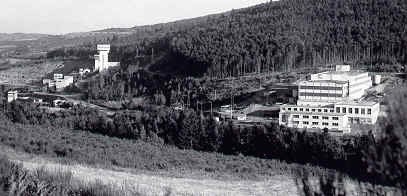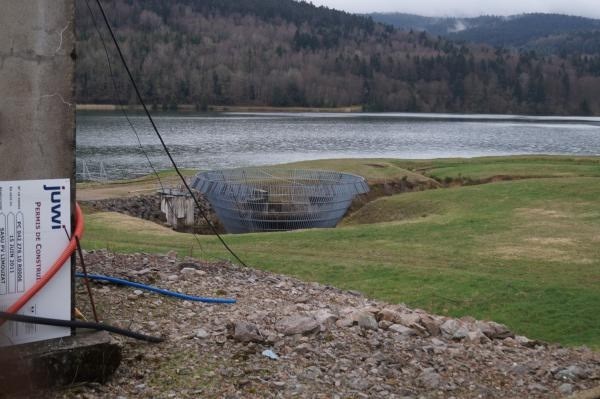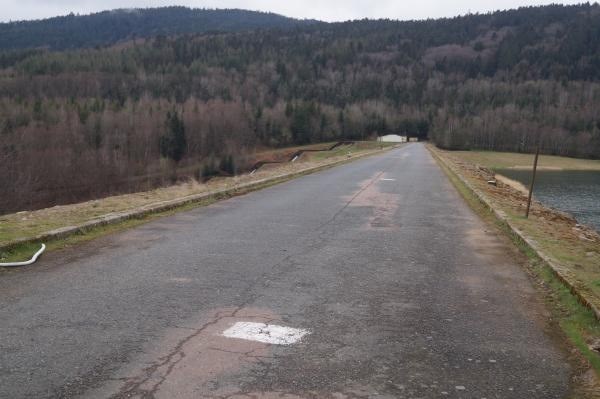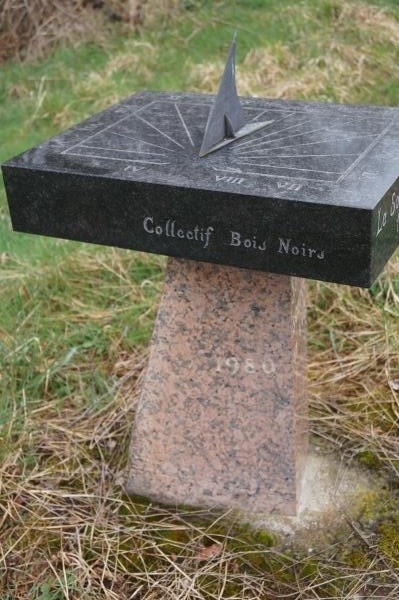L'origine de cette exploitation remonte à la création du Commissariat à l'Énergie atomique (CEA) par le général de Gaulle (ordonnance du 18 octobre 1945). Les différents gouvernements de la IVe République (1946-1958) ont soutenu les programmes de développement du CEA. Le premier plan quinquennal de l'énergie atomique (1952-1957) avait abouti à la création d'un centre production de plutonium à Marcoule dans le Gard. En juillet 1957 est lancé le deuxième plan quinquennal de l'énergie atomique et le gouvernement de Félix Gaillard décide, le 11 avril 1958, de réaliser en 1960 la première série de tirs expérimentaux d'engins atomiques. Le général de Gaulle officialise et théorise au nom de l'indépendance nationale un programme conçu et mis en place par ses prédécesseurs. La première bombe atomique française explose en février 1960 à Regane au Sahara alors que les autres pays occidentaux et l'URSS observaient alors un moratoire sur les expérimentations à ciel ouvert. C'est dans ce contexte qu'est développée l'exploitation du gisement d'uranium de Saint-Priest-La-Prugne.
L'essentiel des ressources françaises en minerais d'uranium français, généralement de faible teneur, se trouve dans des gisements associés à des granites. Leur exploitation se fait par mines à ciel ouvert ou par des travaux miniers souterrains pour la partie profonde.
Le gisement a été découvert en 1951. Le gisement du Limouzat, situé à 3 km environ à l’ouest du village de Saint-Priest-la-Prugne sur 1,5 km de longueur se situe dans une structure faillée. Il s’agit d’un filon siliceux situé en bordure nord du massif granitique des Bois-Noirs. Le minerai contenu dans ce filon se trouve en majorité sous forme de pechblende. On trouve également quelques traces de tornernite.
La pechblende, également appelée uraninite, est un minéral radioactif qui représente le principal minerai d'uranium. C'est aussi à partir de ce minerai que Pierre et Marie Curie ont extrait le radium.
La pechblende se trouvait en abondance dans les mines d'argent de Bohême. Son nom signifie « fausse poix » en allemand, de pech (« poix ») et blende (« trompeur »). La pechblende formait en effet d'abondantes veines sombres et stériles dans les mines argentifères. L'uranium est mis en évidence en 1789 par le chimiste prussien Martin Heinrich Klaproth qui examine de la pechblende extraite de la mine argentifère de Saint Joachimsthal. C'est en recherchant tous les produits contenus dans ce minerai que Marie Curie découvrit, en 1898, le polonium puis le radium. En effet, Marie Curie, à l'époque jeune doctorante embauchée par Henri Becquerel pour étudier les rayons uraniques, travailla d’abord sur l’uranium puis sur la pechblende, dont le rayonnement bien plus intense venait d'être remarqué. Elle mit en place une méthode radiochimique afin de déterminer l’origine précise du rayonnement de la pechblende : diviser, puis purifier, puis précipiter. Cette méthode était censée permettre d'isoler l'élément seul responsable du rayonnement.
En 1898, furent ainsi mesurées l’activité d’un atome de radium, puis celle du polonium. Pour leur étude de la radioactivité, Henri Becquerel et Pierre et Marie Curie obtinrent le prix Nobel de physique en 1903. La découverte du radium et du polonium permit ensuite à Marie Curie de recevoir le prix Nobel de chimie en 1911. Ce fut la première démonstration de l’existence des atomes de radium et de polonium, qui existent mais sont instables. Cette découverte remit en cause la conception grecque antique qui stipulait que la matière était insécable et éternelle, et qu'il existait donc un nombre fini d'atomes stables.
Après des années d'exploration dès 1955, commence en 1960 l'exploitation de la mine des Bois-Noirs.

Une mine d’uranium n’est pas différente d’une autre mine métallique, la mine de Saint Priest a un développement d’environ 11 kilomètres de galeries. Elle est équipée de 2 puits dont l’un a 200 mètres de profondeur, l’autre 400 mètres. Si vous voulez, suivons les mineurs au fond de la mine, prenons la cage qui descend à 4 mètres seconde et allons jusqu’au niveau 200, c’est-à dire à 200 mètres de profondeur, là où se trouvaient les chantiers d’abattage. Les mineurs forent le filon, tirent le minerai à l’explosif, raclent les produits jusqu’à des berlines de 1800 litres. Ces produits sont ensuite acheminés vers le puits, là ils sont culbutés dans un skip de 5 tonnes. Sont extraits ainsi tous les jours de l’ordre de 600 tonnes. Les produits une fois extraits sont acheminés vers l’atelier de broyage. D’abord, concassés à 120 millimètres, le minerai est repris par un broyeur. Là, le produit est transformé en une boue très fine, les grains ont une dimension moyenne de 160 microns. Cette boue est ensuite pompée vers l’usine chimique, elle est contrôlée auparavant par toutes sortes d’appareils. Nous mesurons ainsi le débit de la boue, son poids, sa teneur, sa densité
L'usine de traitement chimique des minerais fut confiée à la Société Industrielle des Minerais de l'Ouest (SIMO). Le traitement des minerais était réalisé dans deux unités distinctes : l'atelier de préparation des minerais situé à proximité des deux puits d'extraction. Après le passage dans un cylindre compteur (mesure du rayonnement gamma), le minerai était concassé deux fois, d'abord pour débourbage, ensuite un concassage secondaire était associé au broyage. L'ensemble était enfin réduit en pulpe décantée avant d'être pompée vers l'usine de traitement. Construite à proximité du site minier, elle fut mise en service en février 1960. Sise à 600 mètres en amont de la mine, l'usine a une capacité annuelle de traitement de 180 000 t de minerai avec une production de 330 t d'uranium et un rendement de 95 %, fournissait du nitrate d'uranyle très pur contenant 25 % de métal. Le produit final était liquide. Il était ensuite versé dans des containers en acier inoxydable. Les effectifs de la mine évoluent peu : 470 en 1958, 422 en 1963, 322 en 1974. Les effectifs de l'usine, selon les périodes ont évolué de 110 à 170 personnes. Au total donc, au plus fort de l'activité, le site comptait environ 650 à 700 personnes. La mine d'uranium a été très vite mécanisée par l'introduction d'engins mécaniques de forage, d'abattage et de transport.
En 20 ans, de 1960 à juillet 1980, l’usine de Saint-Priest a traité 2 584 000 tonnes de minerai contenant 6 718 tonnes d’uranium.
L’exploitation est arrêtée à l’épuisement du gisement des Bois Noirs en 1981. La mine à ciel ouvert et ses galeries ont été recouvertes par un lac artificiel profond de deux mètres ; cette étendue d’eau sert de protection contre les émanations radioactives des déchets d’exploitation. Selon le magazine Capital, l’ancienne mine conserverait 1,3 million de tonnes de résidus faiblement radioactifs en son sein.

Le site est interdit au public et est classé au titre des Installations Classées pour la Protection de l'Environnement. Il fait néanmoins parti du patrimoine historique, industriel et géologique de la région.

Pour valider cette earth cache vous devrez répondre aux questions suivantes :
1- Quelle est la différence entre l'uranium qui était extraite dans la mine du Limouzat et l'uranium dit enrichi
2- Quels sont les rayonnements ionisants émis par l'uranium naturel (Wikipedia est ton ami)?
3- À l'extérieur du site, au niveau de l'entrée, vous pouvez découvrir deux blocs de roche extraits de la mine, une veine verte est largement visible, quelle est la largeur moyenne de cette veine ? Selon vous quelle est la nature du minerai qui forme la veine verte, tornernite ou pechblende ?
Loguez cette cache "Found it" et envoyez-moi vos propositions de réponses soit via mon profil, soit via la messagerie geocaching.com (Message Center), et je vous contacterai en cas de problème.
English
The atomic industry of France was born after the Second World War. This industry to licence not only the energy independence of France but the military independence. Here in the limits of the departments of the Loire, Puy de Dôme and Allier, in Saint-Priest-la-Prugne, the extraction of uranium lasted from 1956 still 1980.
The origin of this exploitation goes back to the creation of the Atomic Energy Commission (CEA)((ATOMIC ENERGY COMMISSION)) by the general de Gaulle (prescription of October 18th, 1945). The various governments of the IVth Republic ( 1946-1958 ) supported the development programs of the CEA(ATOMIC ENERGY COMMISSION). The quinquennial foreground of the atomic energy ( 1952-1957 ) had ended in the creation of a center production of plutonium to Marcoule in the Gard. In July, 1957 is thrown the second five year plan of the atomic energy and the government of Félix Gaillard decide, on April 11th, 1958, to realize in 1960 the first series of experimental shootings of atomic missiles. The general de Gaulle officializes and theorizes in the name of the national independence about a program conceived(designed) and set up by his predecessors. The first French atom bomb explodes in February, 1960 to Regane in Sahara while the other western countries and the USSR observed then a moratorium on the open-air experiments. It is in this context that is developed the exploitation of the deposit of uranium of Saint-Priest-La-Prugne.
The main part of the French resources in ores of French uranium, generally low content, is in deposits associated to pebbleweaves. Their exploitation is made by opencast mines or by subterranean mining works for the deep part.
The deposit was discovered in 1951. The deposit of Limouzat, situated in approximately 3 km on the West of the village of Saint-Priest-la-Prugne on 1,5 km in length is situated in a structure faillée. It is a siliceous vein situated in north border of the granitic massif of the Wood-blacks. The ore contained in this vein is for the greater part in the form of pitchblende. We also find some tracks of tornernite.
The pitchblende, also called uraninite, is a radioactive mineral which represents the main ore of uranium. It is as well from this ore as Pierre and Marie Curie extracted the radium. The pitchblende was in abundance in the silver mines of Bohemia. His name means "false pitch" in German, of pech ("pitch") and blende ("deceiver"). The pitchblende indeed formed of plentiful dark and sterile veins in the argentiferous appearances. The uranium is highlighted in 1789 by the Prussian chemist Martin Heinrich Klaproth who examines of the pitchblende extracted from the saint Joachimsthal's argentiferous appearance. While looking for all the products contained in this ore Marie Curie discovered, in 1898, the polonium then the radium. Indeed, Marie Curie, in the time young PhD student hired by Henri Becquerel to study the uranic beams, worked at first on the uranium then on the pitchblende, the more intense brilliance of which was to be noticed. She set up a radiochemical method to determine the precise origin of the brilliance of the pitchblende: divide, then cleanse, then precipitate. This method was supposed to allow to isolate the element solely responsible for the brilliance.
In 1898, were so measured the activity of an atom of radium, then that of the polonium. For their study of the radioactivity, Henri Becquerel and Pierre and Marie Curie obtained the Nobel Prize in Physics in 1903. The discovery of the radium and the polonium allowed then Marie Curie to receive the Nobel Prize in Chemistry in 1911. It was the first demonstration of the existence of the atoms of radium and of polonium, that exist but are unstable. This discovery questioned the antique Greek conception(design) which stipulated that the material(subject) was indivisible and eternal, and that there was thus a number finished by stable atoms.
After years of exploration from 1955, begin in 1960 the exploitation of the mine of the Wood-blacks.

An mine of uranium is not different from another metallic mine saint Priest's mine has a development about 11 kilometers of galleries. it´s equipped with 2 wells among which the one is 200 meters deep, the other one 400 meters. If you want, let us follow the minors at the bottom of the mine let us take the cage which comes down to 4 meters assist and let us go until the level 200, it is to be said as deep as 200 meters, where were the construction sites of slaughter(cutting down). The minors drill the vein, pull(fire) the ore in the explosive, scrape products up to 1800 liter sedans. These products are then forwarded to the well, there they are knocked over in a skip of 5 tons.
Are extracted so every day of the order of 600 tons. Products once extracts are forwarded to the workshop of grinding. At first, crushed in 120 millimeters, the ore is resumed by a crusher. There, the product is transformed into a very fine mud, grains have an average dimension of 160 microns. This mud is then pumped towards the chemical factory, it is previously checked by any sorts of devices.
The chemical processing plant of ores was confided(entrusted) to the Industrial Company(Society) of the western Ores ( SIMO). The treatment(processing) of ores was realized in two different units: the workshop(studio) of preparation of ores situated near both winding shafts. After the passage in a cylinder meter (measure of the gamma radiation), the ore was twice crushed, at first for débourbage, then a secondary crushing was associated with the grinding. The set was finally reduced to pulp settled before being pumped towards the processing plant. Built near the mining site, it was put into service in February, 1960. Located in 600 meters upstream to the mine,the factory has an annual capacity of treatmnet of 180 000 t of ore with a production of 330 t of uranium and a 95 % yield), supplied with some nitrate of uranyle very pure containing 25 % of metal. The end product was liquid. it was then poured into stainless steel containers. The staff of the mine evolve little: 470 in 1958, 422 in 1963, 322 in 1974. The staff of the factory, according to periods evolved from 110 to 170 people. All in all thus, at the height of the activity, the site counted approximately 650 to 700 people.
The mine of uranium was very fast mechanized by the introduction of mechanical machines of drilling, slaughter and transport.
In 20 years, from 1960 till July, 1980, the factory of Saint-Priest handled 2 584 000 tons of ore containing 6 718 tons of uranium.
The exploitation() is stopped() in the exhaustion of the deposit of Black Wood in 1981. The opencast mine and its galleries were covered by an artificial lake two meters deep; this area() of water serves as protection against the radioactive emanations of the waste of exploitation(). According to the Major magazine, the former mine) would keep) 1,3 million tons of weakly radioactive residues within it.

The site is forbidden to the public and is classified in conformance with the Installations Classified for the Environmental protection. He makes nevertheless left the historical, industrial and geologic heritage of the region.

To validate this earth hides you will have to answer the following questions :
1- Which is the difference enters the uranium which was extracted in the appearance of Limouzat and the uranium says enriched ?
2- What are ionizing radiations emitted by the natural uranium (Wikipedia is one friend)?
3- Outside of the site, at the level of the entrance, you can discover two blocks of rock extracted from the appearance(mine), a green vein is widely visible, what is the average width of this vein ?
Sources :
http://encyclopedie-dd.org/encyclopedie/territoires/3-3-les-dechets/apres-l-exploitation-de-la-mine-d.html
http://fresques.ina.fr/rhone-alpes/fiche-media/Rhonal00227/la-mine-d-uranium-a-saint-priest-la-prugne.html
http://www.forez-info.com/encyclopedie/le-saviez-vous/148-quand-la-loire-produisait-de-luranium.html
https://fr.m.wikipedia.org/wiki/Pechblende
https://mimausabdd.irsn.fr

